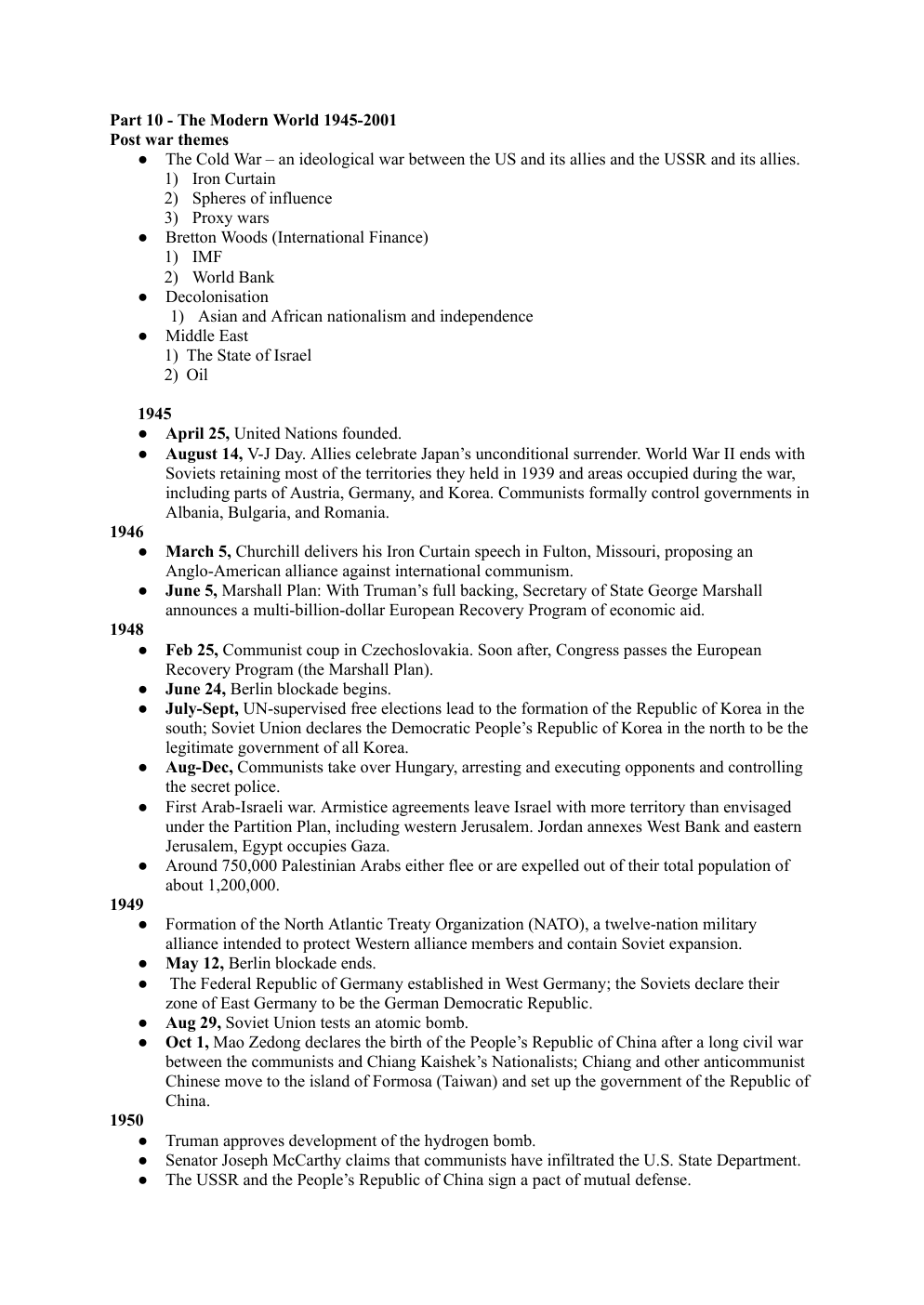Part_10_The_Modern_World_Course_Notes
Publié le 08/05/2023
Extrait du document
«
Part 10 - The Modern World 1945-2001
Post war themes
● The Cold War – an ideological war between the US and its allies and the USSR and its allies.
1) Iron Curtain
2) Spheres of influence
3) Proxy wars
● Bretton Woods (International Finance)
1) IMF
2) World Bank
● Decolonisation
1) Asian and African nationalism and independence
● Middle East
1) The State of Israel
2) Oil
1945
● April 25, United Nations founded.
● August 14, V-J Day.
Allies celebrate Japan’s unconditional surrender.
World War II ends with
Soviets retaining most of the territories they held in 1939 and areas occupied during the war,
including parts of Austria, Germany, and Korea.
Communists formally control governments in
Albania, Bulgaria, and Romania.
1946
● March 5, Churchill delivers his Iron Curtain speech in Fulton, Missouri, proposing an
Anglo-American alliance against international communism.
● June 5, Marshall Plan: With Truman’s full backing, Secretary of State George Marshall
announces a multi-billion-dollar European Recovery Program of economic aid.
1948
● Feb 25, Communist coup in Czechoslovakia.
Soon after, Congress passes the European
Recovery Program (the Marshall Plan).
● June 24, Berlin blockade begins.
● July-Sept, UN-supervised free elections lead to the formation of the Republic of Korea in the
south; Soviet Union declares the Democratic People’s Republic of Korea in the north to be the
legitimate government of all Korea.
● Aug-Dec, Communists take over Hungary, arresting and executing opponents and controlling
the secret police.
● First Arab-Israeli war.
Armistice agreements leave Israel with more territory than envisaged
under the Partition Plan, including western Jerusalem.
Jordan annexes West Bank and eastern
Jerusalem, Egypt occupies Gaza.
● Around 750,000 Palestinian Arabs either flee or are expelled out of their total population of
about 1,200,000.
1949
● Formation of the North Atlantic Treaty Organization (NATO), a twelve-nation military
alliance intended to protect Western alliance members and contain Soviet expansion.
● May 12, Berlin blockade ends.
● The Federal Republic of Germany established in West Germany; the Soviets declare their
zone of East Germany to be the German Democratic Republic.
● Aug 29, Soviet Union tests an atomic bomb.
● Oct 1, Mao Zedong declares the birth of the People’s Republic of China after a long civil war
between the communists and Chiang Kaishek’s Nationalists; Chiang and other anticommunist
Chinese move to the island of Formosa (Taiwan) and set up the government of the Republic of
China.
1950
● Truman approves development of the hydrogen bomb.
● Senator Joseph McCarthy claims that communists have infiltrated the U.S.
State Department.
● The USSR and the People’s Republic of China sign a pact of mutual defense.
●
●
1953
●
●
●
●
1954
●
1955
●
1956
●
●
1957
●
1958
●
●
1959
●
1961
●
●
●
●
1962
●
●
1964
●
●
1965
Communist North Korea invades South Korea with military support from the Soviet Union.
Truman and the United Nations call for a defense of South Korea.
United States sends forces
(eventually joined by forces from sixteen other countries) led by General MacArthur to Korea.
Stalin dies.
Armistice ends the fighting in Korea, but no peace treaty is signed.
Nikita Khrushchev becomes head of the Soviet Communist Party.
August, Prime Minister Mossadeq is overthrown in a coup engineered by the British
and US intelligence services.
General Fazlollah Zahedi is proclaimed prime minister,
and the Shah returns from temporary exile.
The Southeast Asian Treaty Organization (SEATO) is founded to resist communist aggression.
Member states are Australia, France, New Zealand, Pakistan, Thailand, the Philippines, the
United Kingdom, and the United States.
Warsaw Pact established by the USSR and satellites Albania, Poland, Romania, Hungary, East
Germany, Czechoslovakia, and Bulgaria.
During the Suez Canal Crisis, Eisenhower pressures Britain and France to accept a UN
ceasefire in order to prevent the USSR from assisting Gamal Nasser’s Egypt and expanding
Soviet presence in the Middle East.
Hungarian Revolution begins in October, but after two weeks of freedom, students and
workers protesting Soviet occupation are violently put down and communist rule is
re-established.
Spuknik I satellite launched by the Soviet Union.
The Common Market established by Western European nations.
Mao begins the Great Leap Forward, a collectivization of Chinese agriculture that will cause
the deaths of tens of....
»
↓↓↓ APERÇU DU DOCUMENT ↓↓↓
Liens utiles
- HISTOIRE DU MONDE [History of the World].
- anywher out of the world
- Georgi Dimitrov par Liliana Brisby Editor of " The World Today ", London Né en Bulgarie dans une famille d'ouvriers, Georgi Dimitrov est l'un des rares étrangers à avoir accédé aux plus hautes responsabilités au sein de l'État soviétique.
- Song of the Open Road Leaves of Grass, 1900 Walt Whitman 1 Afoot and light-hearted, I take to the open road, Healthy, free, the world before me, The long brown path before me, leading wherever I choose.
- Seven Wonders of the World - history.

































